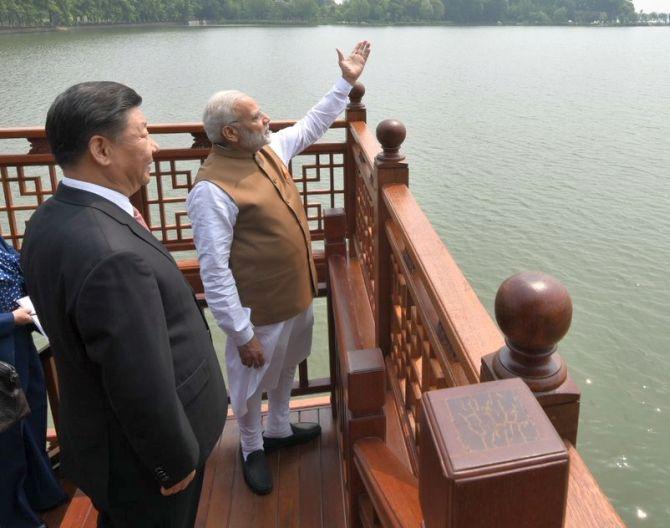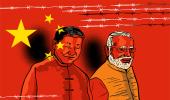'From Doklam to Wuhan and the return of the India-China relationship to its previous equilibrium is indeed a major contribution of President Xi and PM Modi. Without any doubt they deserve the kudos for their sagacity and their wisdom,' says Ambassador Gautam Bambawale, India's envoy to China during the Wuhan summit.

It is exactly one year since the India-China Informal Summit between Prime Minister Modi and President Xi Jinping which had taken place at Wuhan on April 27-28, 2018. Long enough for some of the results of that summit meeting between the leaders of two ancient civilisations, which are also re-emerging on the world stage to recapture their pre-eminence in the global scenario, become apparent. The following paragraphs will attempt an analysis of the Wuhan meeting.
First, India and China, have contributed the concept of 'informal summits' to global diplomatic practice. The seminal Wuhan Informal Summit showed that leadership interaction between two countries could be entirely at the informal level without necessitating any of the bells and whistles that international protocol demands.
Such informal meetings have, in the recent past, been a small part of a larger formal visit by a State leader. However, the meeting in Wuhan, was one of the first which was entirely informal in its setting, in approach and in its implementation.
The reason the two countries agreed to such an 'Informal Leaders Meeting' was to give ample time and space to the leaders to talk to each other on topics which they decided themselves.
Naturally, there was some coordination on the broad subjects to be covered beforehand, but the leaders were free to decide how long to dwell on any one subject or in what direction a particular conversation was to be taken.
While this can even be true of more formal meetings with a set agenda, it is the hallmark of an informal meeting. Hence, India and China, which gave the world the Panchsheel or Five Principles of Peaceful Coexistence in the 1950s, have once again contributed to diplomatic practice in the 21st Century.
The Wuhan Informal Summit between the Indian prime minister and Chinese president was also strong on what is described by some as 'strategic communication'. It was an exercise in understanding the other side's point of view, its dreams, its goals and objectives, its assessments and its strategies.
Starting with each country's civilisational ethic, norms and traditions which shape the reality of today, the two leaders also spoke to one another of the hopes, ambitions and desires of their people.
This translated into mutual understanding of the other's policies, both domestic as well as foreign, the nature of geo-economics and geo-politics, how the two can work together in larger multilateral forums as well as an acknowledgement of the areas where the two sides have differences of opinion and positions.
Such a clear, frank and direct exchange of views would perhaps not have been possible in more formal settings where leaders normally speak from prepared texts and talking points. Informal settings are more amenable to producing candid views and sharing of confidences.
So, President Xi and Prime Minister Modi have been trailblazers in setting new diplomatic precedents and norms.
That the India-China Wuhan Informal Summit has been successful in returning the bilateral relationship to an even keel has become increasingly obvious over the past year. Therein lies its significance as well as its success.
Readers will recollect the ill-temper and fiery rhetoric from China during and in the immediate aftermath of the Doklam incident. From the Indian side was a relatively cool but firm response with the Indian media playing a particularly important role in keeping things in perspective.
From Doklam to Wuhan and the return of the India-China relationship to its previous equilibrium is indeed a major contribution of President Xi and PM Modi. Without any doubt they deserve the kudos for their sagacity and their wisdom.
What have been the results following the Wuhan Informal Summit?
First, ministerial meetings have resumed between the two countries with India's external affairs and defence ministers having visited China and in return China's defence, public security and foreign ministers having been to India in 2018.
While our ministers went to China mainly for SCO meetings, both had an important bilateral segment to their visits. In fact, the Wuhan summit was formally announced to public opinion by External Affairs Minister Sushma Swaraj and Chinese Foreign Minister Wang Yi at their interaction with the media following their bilateral interaction in Beijing.
Raksha Mantri Nirmala Sitharaman too had a very important bilateral with her counterpart Chinese minister which led to a thaw in defence and military cooperation between our countries. The visit to India of China's public security minister and interaction with Home Minister Rajnath Singh has led to new grounds for cooperation between India and China in law enforcement, counter terrorism and intelligence sharing. This will prove to be of particular significance in the years ahead.
In December 2018, the foreign ministers of India and China held their first meeting of the High Level Mechanism on People-to-People Exchanges which has been identified as the weak link in our bilateral ties.
Good political and economic exchanges need to be backed up by higher flows of ordinary citizens between our countries. We need to continue working on this aspect of the relationship.
Second and very significantly, military exchanges too have resumed with interactions between our Eastern Army Command and China's Western Theater Command. Since these are the commanders and troops which man significant sections of our common frontier, it is important for them to meet each other and attempt to understand the workings of the other side including how they react to situations on the ground.
What is even more important is the resumption of naval cooperation as was seen recently with the visit of two Indian Navy ships to Qingdao this April to participate in China's International Fleet Review.
Defence exchanges should not merely be limited to study visits, attending courses in the military schools of the other side and perfunctory port calls by naval ships. They need to go beyond such symbolism and aim at getting a better understanding of the doctrines, practices and assessments of the other side. Naturally, this will not be immediately possible but a start has to be made somewhere.
On the border itself, there is a need for new Confidence Building Measures which will aim at defusing the increasing close proximity situations that have been witnessed in the recent past. Additional Standard Operating Procedures may also have to be put into place.
Third, India's trade deficit with China has narrowed even while trade has continued its expansion. This is heartening news even if it does not signal any structural change in two-way commerce. It is the result of great effort on both sides, including at the official and political levels.
However, more needs to be done especially in the export of Indian pharma products and software to China. If we are able to sell these items to China, only then will there be a basic change in the deficit picture.
To tackle the trade imbalance, India must focus on getting more Chinese tourists to India as well as on ensuring that Chinese firms invest in greenfield ventures in our country.
Fourth, readers must have taken note that the India-China boundary has been relatively quiet this summer as a result of the understanding between PM Modi and President Xi. This has enabled India to focus on our domestic politics of a general election even though our western borders have been challenging.
Finally, India has become an active member of the Shanghai Cooperation Organisation participating in all its activities including joint military exercises. This provides India with strategic and diplomatic space even as we strengthen our cooperation with the United States and Japan.
That Chinese Foreign Minister Wang Yi has already announced to the media that his country is looking forward to a second Informal Summit later in 2019 indicates that China too feels that this format has proved successful. It is very likely that Foreign Secretary Vijay Gokhale discussed this matter during his just concluded visit to Beijing.
However, a precise date can only be worked out once the newly elected Government of India takes office. Be that as it may, it appears to most observers that the Informal Summit option for leadership level meetings seems to be here to stay.
Gautam Bambawale has served as India's Ambassador to Bhutan, Pakistan and China. He was present at Wuhan in the capacity of Indian Ambassador to China. He is currently Distinguished Professor, Symbiosis International University, Pune. Views are personal.










